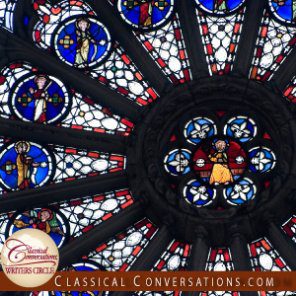Imagine I gently place a piece of colored glass in your hand. You could study its color, texture, size, and shape. Now, imagine I place more pieces in your hand until your hand is full. After studying each piece, you may decide you like some pieces better than others, but pretty soon, you will lose interest in them and set them aside, or let them drop from your hand.
What if I told you each piece of glass has a special place in the most beautiful stained glass window in the most beautiful cathedral ever built? (The one pictured here is in Notre Dame, in Paris.) What if I took you to see this work of art so you could see how the colored light fills the cathedral like sunlight that dapples the forest floor and how it creates an ethereal atmosphere in the whole space and becomes a part of the worship that takes place there?
Those pieces of glass become meaningful if you know that they are part of something amazing.
Education has become something like a handful of separate, fragmented pieces of glass. We hand our children one subject at a time, trying to collect all the pieces they need, but we fail to show them the glorious work of art of which each piece is a part.
In classical Christian education, we present each subject in its context: every subject was created by God and every subject is under the authority of God. For example, God created linear symmetry and tells the leaves on a branch to grow in that symmetry: some in alternating pattern, some in reflective symmetry, some in radial symmetry. You can see how God uses geometry in seashells, fruit slices, the rings of tree stumps, and all creatures. It is the math (symmetry, pattern, balance, and so on) that creates beauty in nature.
Subject integration is one of the big ideas we talk about at parent practicums. It is a big change in the way we think about education. How will we put it into practice at home? Most of us were taught subjects separately and it can be difficult to see how to put integration into practice in the daily planner.
You have already taken a step in the right direction if you have had your students learn to write well by writing papers about science or history, and by having them draw an illustration to go with it. In one assignment, you can teach writing, reading, research, science, history, and art.
You can also begin to integrate subjects by using the PreScripts books andClassical Acts and Facts History Cards (timeline). In these books, students practice cursive writing and drawing while they learn about a particular subject. For example, in the medieval history PreScripts book, students will copy a sentence about Charlemagne. The sentence is repeated in order to help the student memorize the facts. With the timeline card, students can read more about the people and events and see the related area on a map. The timeline card also shows a work of art or a photo related to the person or event. This artwork is reproduced in the PreScripts book in outline form so the student can color it or practice their drawing skills by redrawing the artwork themselves. There is also a short lesson on each piece of art which points out a technique and some art vocabulary such as depth or symmetry in the composition.
There are two books that complement Foundations Cycle 2 which is coming up this year. The PreScripts Cursive Sentences and Art Lessons: Medieval to Modern World History book would be a great choice for kids approximately nine to twelve years old.
For younger students, PreScripts Cursive Letters and Coloring: Medieval to Modern World History would be a good choice. In the second book, students color the drawing, practice a cursive letter, and then they are given a step-by-step drawing to trace. These activities are designed to help young students develop hand-eye coordination. The history drawings will make them feel a part of the studies with their older siblings, and they will participate in an integrated lesson with a little art, history, and handwriting, too.
The PreScripts books come in four levels of difficulty. Age recommendations are not offered because children can differ significantly in their abilities. Choose the level you think would offer good practice for your child without his or her being frustrating. Look for the key words in the titles: “Letters” is the easiest, progressing in difficulty to “Words,” to “Sentences,” and then to “Passages.”
I hope these tools will help you put the pieces of fragmented subjects back together and show your children how every subject fits into “the stained glass window” and glorifies God!
_______________________________________________________________________
One of the distinctive qualities of classical Christian education is subject integration. In modern education, the subjects are separated and taught by specialists.




